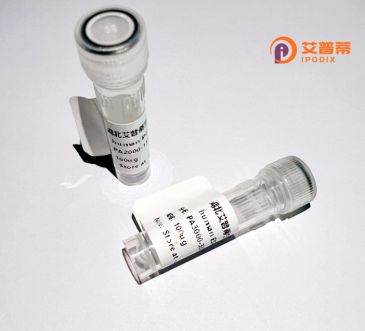
| 纯度 | >90%SDS-PAGE. |
| 种属 | Human |
| 靶点 | IFIT1 |
| Uniprot No | P09914 |
| 内毒素 | < 0.01EU/μg |
| 表达宿主 | E.coli |
| 表达区间 | 1-478aa |
| 氨基酸序列 | MSTNGDDHQVKDSLEQLRCHFTWELSIDDDEMPDLENRVLDQIEFLDTKYSVGIHNLLAYVKHLKGQNEEALKSLKEAENLMQEEHDNQANVRSLVTWGNFAWMYYHMGRLAEAQTYLDKVENICKKLSNPFRYRMECPEIDCEEGWALLKCGGKNYERAKACFEKVLEVDPENPESSAGYAISAYRLDGFKLATKNHKPFSLLPLRQAVRLNPDNGYIKVLLALKLQDEGQEAEGEKYIEEALANMSSQTYVFRYAAKFYRRKGSVDKALELLKKALQETPTSVLLHHQIGLCYKAQMIQIKEATKGQPRGQNREKLDKMIRSAIFHFESAVEKKPTFEVAHLDLARMYIEAGNHRKAEENFQKLLCMKPVVEETMQDIHFHYGRFQEFQKKSDVNAIIHYLKAIKIEQASLTRDKSINSLKKLVLRKLRRKALDLESLSLLGFVYKLEGNMNEALEYYERALRLAADFENSVRQGP |
| 分子量 | 62.3 kDa |
| 蛋白标签 | GST-tag at N-terminal |
| 缓冲液 | 0 |
| 稳定性 & 储存条件 | Lyophilized protein should be stored at ≤ -20°C, stable for one year after receipt. Reconstituted protein solution can be stored at 2-8°C for 2-7 days. Aliquots of reconstituted samples are stable at ≤ -20°C for 3 months. |
| 复溶 | Always centrifuge tubes before opening.Do not mix by vortex or pipetting. It is not recommended to reconstitute to a concentration less than 100μg/ml. Dissolve the lyophilized protein in distilled water. Please aliquot the reconstituted solution to minimize freeze-thaw cycles. |
以下是关于重组人IFIT1蛋白的3篇参考文献及其概括:
1. **文献名称**:*Crystal structure of human IFIT1 reveals the intrinsic capacity for RNA recognition*
**作者**:Hsu, A. C., et al.
**摘要**:本研究解析了人IFIT1蛋白的晶体结构,揭示了其通过羧基末端结构域特异性识别病毒RNA的5'-三磷酸基团(5'ppp)的分子机制,解释了IFIT1抑制RNA病毒复制的结构基础。
2. **文献名称**:*IFIT1 inhibits hepatitis C virus replication by binding to 5' untranslated region*
**作者**:Raychoudhuri, A., et al.
**摘要**:文章证明重组人IFIT1蛋白可直接结合丙肝病毒(HCV)RNA的5'非翻译区,通过阻断病毒翻译复合体的形成抑制病毒复制,依赖其干扰素诱导特性发挥抗病毒功能。
3. **文献名称**:*The interferon-induced protein IFIT1: a key player in antiviral immunity*
**作者**:Fensterl, V., & Sen, G. C.
**摘要**:该综述系统总结了IFIT1在抗病毒固有免疫中的作用,强调其通过结合病毒RNA或调控信号通路抑制多种病毒(如流感、登革热病毒),并提及重组IFIT1在体外研究中的工具性应用。
4. **文献名称**:*Optimized expression and purification of recombinant human IFIT1 in Escherichia coli*
**作者**:Guo, Y., et al.
**摘要**:研究报道了一种高效的大肠杆菌表达系统用于重组人IFIT1生产,通过优化密码子及纯化步骤获得高纯度蛋白,并验证其体外RNA结合活性,为功能研究提供可靠材料。
---
以上研究涵盖结构解析、功能机制、综述及应用方法,均为IFIT1研究的关键方向。
Interferon-induced protein with tetratricopeptide repeats 1 (IFIT1), also known as ISG56. is a key mediator of the innate immune response to viral infections. It belongs to the IFIT family, which is transcriptionally upregulated by type I and III interferons (IFNs) upon pathogen detection. IFIT1 primarily functions as a antiviral protein by binding to viral RNA, particularly those lacking 2'-O methylation on their 5' cap structures, thereby inhibiting viral translation and replication. Its activity extends to modulating immune signaling pathways and interacting with host proteins involved in RNA metabolism.
Recombinant human IFIT1 protein is produced using genetic engineering techniques, typically expressed in Escherichia coli or mammalian cell systems to ensure proper post-translational modifications. This engineered protein retains the functional domains necessary for RNA-binding and protein-protein interactions, enabling researchers to study its mechanisms in controlled experimental settings. Purification methods often involve affinity chromatography tags (e.g., His-tag) followed by rigorous quality control assessments.
As a research tool, recombinant IFIT1 facilitates studies on IFN-mediated antiviral responses, host-pathogen interactions, and viral evasion strategies. It serves as valuable material for structural analysis, biochemical assays, and screening antiviral compounds. Compared to native proteins isolated from human cells, the recombinant version offers higher purity, batch consistency, and scalability while avoiding ethical concerns associated with human tissue sources.
×